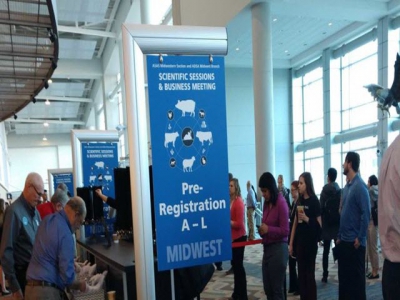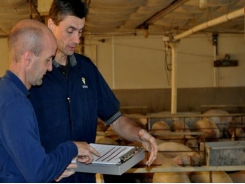Target diet, appetite during disease challenge in nursery pigs

Midwest ASAS/ADSA meetings: Nutrient partitioning and metabolism priorities of nursery pigs altered during pathogen challenge.
Speaking to the Gary Allee Symposium at the Midwest section meetings of the American Society of Animal Science (ASAS) and American Dairy Science Assn. (ADSA) in Omaha, Neb., Dr. Nick Gabler of Iowa State University examined the role of disease status on the growth and intestinal function of nursery pigs.
Specifically, he addressed to what extent feed intake explains the disease phenotype associated with nursery pigs infected with porcine reproductive and respiratory syndrome (PRRS) virus, which was studied because PRRS is endemic in the midwestern U.S. and is considered a gateway pathogen for other diseases.
Gabler said PRRS infection can reduce average daily feed intake 51% and average daily gain 58% compared to ad libitum-fed healthy pigs. A similar response was observed when healthy pigs were pair fed the same amount of feed as the PRRS-infected pigs. Gabler said this indicates that a reduction in feed intake may explain the PRRS growth response.
In the same study, Gabler and his team also examined the internal organs of the pigs and found that the PRRS-infected pigs had larger lungs, heart, liver and spleen, while the pair-fed pigs had larger intestines, which may have developed as a way for those pigs to get more nutrients out of the limited amount of feed provided.
Regarding what can be done, Gabler reviewed current research his laboratory conducted that demonstrates the influence of the dietary lysine-to-metabolizable energy (ME) ratio, the optimum breakpoint of which shifts to the right to 120% in PRRS-infected pigs.
The digestible lysine:ME ratio is more important than the protein/amino acid source, he added, noting that the main amino acids were all increased in balance in the study.
Gabler concluded that nutrient partitioning and metabolism priorities are altered during a pathogen challenge, leading to changes in intestinal function and integrity. This results in a negative impact on growth and lean tissue accretion.
Diet and appetite need to be targeted to maintain growth performance during a pathogen challenge, he explained.
Related news
Tools

Phối trộn thức ăn chăn nuôi

Pha dung dịch thủy canh

Định mức cho tôm ăn

Phối trộn phân bón NPK

Xác định tỷ lệ tôm sống

Chuyển đổi đơn vị phân bón

Xác định công suất sục khí

Chuyển đổi đơn vị tôm

Tính diện tích nhà kính

Tính thể tích ao



 Early-life stress has lifelong implications for pigs
Early-life stress has lifelong implications for pigs  Calculating swine diets using digestibility ratios may support…
Calculating swine diets using digestibility ratios may support…